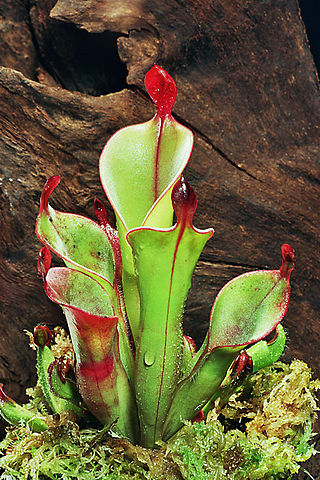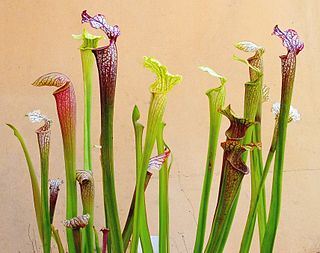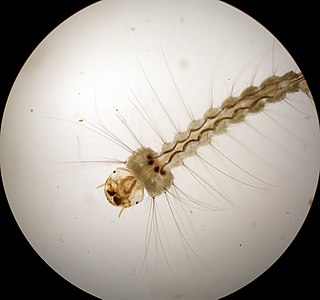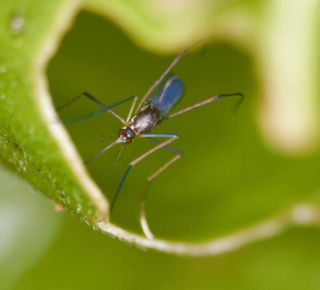
Pitcher plants are carnivorous plants known as pitfall traps—a prey-trapping mechanism featuring a deep cavity filled with digestive liquid. The traps of pitcher plant are considered to be "true" pitcher plants and are formed by specialized leaves. The plants attract and drown the prey with nectar.

Sarraceniaceae are a family of pitcher plants, belonging to order Ericales.

Sarracenia is a genus comprising 8 to 11 species of North American pitcher plants, commonly called trumpet pitchers. The genus belongs to the family Sarraceniaceae, which also contain the closely allied genera Darlingtonia and Heliamphora.

Sarracenia flava, the yellow pitcherplant, is a carnivorous plant in the family Sarraceniaceae. Like all the Sarraceniaceae, it is native to the New World. Its range extends from southern Alabama, through Florida and Georgia, to the coastal plains of southern Virginia, North Carolina and South Carolina. Populations also exist in the Piedmont, Mendocino County, California and mountains of North Carolina.

Sarracenia purpurea, the purple pitcher plant, northern pitcher plant, turtle socks, or side-saddle flower, is a carnivorous plant in the family Sarraceniaceae.

In zoology, an inquiline is an animal that lives commensally in the nest, burrow, or dwelling place of an animal of another species. For example, some organisms, such as insects, may live in the homes of gophers or the garages of humans and feed on debris, fungi, roots, etc. The most widely distributed types of inquiline are those found in association with the nests of social insects, especially ants and termites – a single colony may support dozens of different inquiline species. The distinctions between parasites, social parasites, and inquilines are subtle, and many species may fulfill the criteria for more than one of these, as inquilines do exhibit many of the same characteristics as parasites. However, parasites are specifically not inquilines, because by definition they have a deleterious effect on the host species, while inquilines have not been confirmed to do so.

Phytotelma is a small water-filled cavity in a terrestrial plant. The water accumulated within these plants may serve as the habitat for associated fauna and flora.

Sarracenia rosea is a species of pitcher plant in the genus Sarracenia and is sometimes known as Burk's southern pitcher plant.

Carnivorous plants are plants that derive some or most of their nutrients from trapping and consuming animals or protozoans, typically insects and other arthropods, and occasionally small mammals and birds. They still generate all of their energy from photosynthesis. They have adapted to grow in waterlogged sunny places where the soil is thin or poor in nutrients, especially nitrogen, such as acidic bogs. They can be found on all continents except Antarctica, as well as many Pacific islands. In 1875, Charles Darwin published Insectivorous Plants, the first treatise to recognize the significance of carnivory in plants, describing years of painstaking research.

Habrotrocha rosa is a bdelloid rotifer that has been found in leaf litter, soil, and moss in Europe and New Zealand and also in North America within the pitchers of Sarracenia purpurea, the purple pitcher plant. It is one of many species that make up the inquiline community that thrives within the water-retaining pitcher-shaped leaves of S. purpurea.

Wyeomyia smithii, the pitcher plant mosquito, is an inquiline mosquito that completes its pre-adult life cycle in the phytotelma of—that is, the water contained by—the purple pitcher plant, Sarracenia purpurea. In this microcommunity of bacteria, rotifers, protozoa, and midges, W. smithii is the top-level predator; its presence determines the bacterial species diversity within the pitcher.
Meadowview Biological Research Station is a non-profit 501(c)(3) organization dedicated to preserving and restoring rare wetland plants, habitats and associated ecosystems on the coastal plain of Maryland and Virginia. It was created in 1995 with the specific goal or restoring the rare yellow pitcher plant, the purple pitcher plant, and associate species to pitcher plant bogs or seepage wetlands in their historic ranges.

The Sifton Bog Environmentally Significant Area is a wetland jointly administered by the city of London, Ontario and the Upper Thames River Conservation Authority. It is located west of Hyde Park Road and south of Oxford Street inside the city limits of London, Southern Ontario, Canada. It is a Class 2 provincially significant wetland.

Metriocnemus is a genus of non-biting midges in the subfamily Orthocladiinae of the bloodworm family Chironomidae.

Colpoda is a genus of ciliates in the class Colpodea, order Colpodida, and family Colpodidae.
Exyra fax, the pitcher plant moth, is a moth of the family Noctuidae. It is mainly found on the Atlantic Coastal Plain and Great Lakes region of eastern North America (from Manitoba through Michigan to Nova Scotia and Maine south to Georgia. The species is listed as threatened in Connecticut.

Sarracenia jonesii is a species of pitcher plant endemic to seepage bogs in the appalachian mountains of North Carolina and South Carolina. It is currently only found in ten locations: 4 in North Carolina and 6 in South Carolina. S. jonesii is listed as endangered by the US federal government.

The North American continent is home to a wide variety of carnivorous plant species. Species from seven genera are native to the continent, and three of these genera are found nowhere else on the planet.
Catalina Cuellar-Gempeler is a Colombian microbial ecologist and marine microbiologist, currently an Associate Professor at Cal Poly Humboldt. Her research focuses on understanding microbial metacommunity dynamics, eco-evolutionary dynamics, and ecosystem dynamics. Her research group, the CGlab uses host associated microbial communities as a model system to understand how processes of community assembly result in patterns of diversity and function. The lab's main emphasis is on the microbes used in digestion in the Californian and Eastern carnivorous pitcher plants. In March 2021, Cuellar-Gempeler was awarded an Early Career grant of $1 million by the National Science Foundation.

Sarracenin is an iridoid found in several plant species in the carnivorous family Sarraceniaceae. It also occurs in other non-carnivorous plants such as Strychnos spinosa (Loganiaceae) and Patrinia heterophylla (Caprifoliaceae).

















